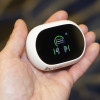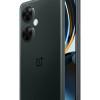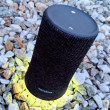Review: Samsung Galaxy S 4G
Feb 22, 2011, 8:56 AM by Eric M. Zeman
updated Mar 4, 2011, 11:38 AM
Samsung has updated the Vibrant variant of its Galaxy S line with HSPA+ at 21Mbps. Is a faster data radio worth the upgrade? Find out in Phone Scoop's review.
Is It Your Type?
Since the Samsung Galaxy S 4G is so similar to the Samsung Vibrant, Phone Scoop has prepared a mini-review of the device focusing on the major differences: the faster mobile broadband radio and the new user-facing camera. For Android lovers who are in a hurry, there's a lot to like.
Body
Samsung's Galaxy S 4G is a near carbon-copy of the Samsung Vibrant that debuted on T-Mobile's network last summer. In fact, a side-by-side comparison of the two phones will reveal only two changes. First, the color of the battery cover is different. It has a silver-burst finish to it, rather than the speckled black seen on the Vibrant. Second, it will take the sharp-eyed to spot the small, user-facing camera on the face of the Galaxy S 4G. Otherwise, physically, these devices are identical.
It is a big slab of a phone that feels fairly light in the hand, but still solid and well made. Most surfaces are either plastic or glass, and it comes off a bit slippery in the hand. The front is dominated by the large touch screen. There are four capacitive buttons placed at the bottom edge to access the standard Android Menu, Home, Back, Search actions. They offer the option to include haptic feedback (micro vibrations) when touched.
The volume toggle is on the left side of the Galaxy S 4G and it is small-ish with minimal travel and feedback. The power/lock key is located on the right side of the phone. I'd have preferred if Samsung had listened to my complaints about this key and made it somewhat bigger.
The 3.5mm headset jack is located on the top of the phone, as is the microUSB port, which is covered by a little door. The door slides sideways to reveal the port. The microSD card slot is located under the battery cover, but thankfully not under the battery itself. The entire back surface of the Galaxy S 4G peels off easily to access both the battery and microSD card.
Speaking of the microSD card, it is worth noting a serious change made to the on-board storage situation. The Vibrant had 16GB of storage built into the device. The Galaxy S 4G has 185MB. Yeah, that's a pretty big difference. Now, the Galaxy S 4G comes with a 16GB microSD card installed, but the Vibrant could have added a 32GB card in addition to the built-in storage, making for a total of 48GB. The Galaxy S 4G is limited to a total storage capacity of 32GB. Perhaps not the biggest deal in the world, but definitely worth noting — especially since 185MB on the device leaves very little room for applications.
Also, the battery is slightly bigger. Despite the larger size, the Galaxy S 4G has slightly shorter talk and stand-by times for the Galaxy S 4G when compared to the Vibrant.
Performance
The Galaxy S 4G has the same 1GHz Hummingbird processor; same 5 megapixel camera with 720p HD video capture; same 4-inch Super AMOLED display; and the same Wi-Fi, Bluetooth, and GPS support. It is, however, running a slightly updated version of TouchWiz on Android 2.2.1 Froyo (as opposed to 2.1 Eclair).
The display looks fantastic. The battery easily lasted through an entire day (full 24 hours) of extensive use. Call quality was for the most part very good, with a few minor trouble spots here and there. And the Galaxy S 4G easily found and latched onto T-Mobile's HSPA+ network, though it dropped to 3G and even EDGE a handful of times.
The one change that makes a significant different, however, is the radio support. Where the Vibrant supported HSDPA at 7.2Mbps, the Galaxy S 4G supports HSPA+ at 21Mbps. In raw speed tests over 4G, I managed to see a peak download speed of 7.1Mbps, with an average download speed of 5.474Mbps. On the upload side of the equation, I saw a peak of 1.857Mbps, and the average upload speed over 4G was 1.811Mbps. Network latency ranged between 72ms and 242ms, with the average at about 90ms. (Keep in mind these are real-world speeds.)
How does that translate into everyday use? Full HTML web sites load in a blink. Phonescoop.com, for example, loaded in 1 second. That's the fastest I've ever seen Phonescoop.com load on any mobile device (even ones using dedicated Wi-Fi). The full CNN.com web site loaded in 4 seconds. It normally takes 7 to 15, depending.
Likewise, applications downloaded from the Android Market in a flash. The Galaxy S pulled down 10MB applications in just a few seconds.
If you're looking for a phone that has access to a fast data network, the Galaxy S 4G doesn't disappoint.
Basics
With TouchWiz and Android 2.2.1 on board, the Galaxy S 4G doesn't offer any surprises in terms of raw capabilities. All the same calling, contacts, messaging, and social networking tools apply. I had no trouble setting up Gmail, Facebook, Twitter, or other accounts.
While I still don't find this version of TouchWiz to be visually appealing, it isn't horrible to use. The menus and user interface are (overly) colorful, with a rainbow of apps dashing across the main app page. It moves lightning fast, and I experienced no hiccups.
Extras
T-Mobile and Samsung have installed some new software and applications onto the Galaxy S 4G that weren't on the Vibrant.
First, the Galaxy S 4G has doubleTwist with AirSync installed. Coupled with the proper desktop software, this lets users wirelessly sync iTunes or Windows Media Player content between their phone and PC using Wi-Fi. In practice, it works as advertised... almost. Using it with an Apple product took some finagling of the desktop software, and it seemed to have trouble with larger playlists (>2GB). With patience, however, it worked. Since it isn't any faster for transferring when compared to sideloading to the device or directly on the microSD card, I don't see the immediate appeal of this software (unless you're wire-averse).
Qik's video chat software is also on board. This software also works, but can be flaky. I had about as much success using it as I have on other Qik-equipped devices. That is to say, with effort, you can conduct video chats of middling quality. I hate to make the comparison, but Apple's FaceTime still bests Qik in terms of raw ease-of-use, though Qik's compatibility with 3G/4G networks is a major feature that FaceTime doesn't have.
The Galaxy S 4G also has Samsung's Media Hub/Social Hub on board for song and movie downloads and social networking. It is also the first device I've seen that comes with the Layar browser (for augmented reality apps) installed out of the box.
One odd omission: No mobile hotspot app / support. At least none that I could find.
UPDATE: I found the hotspot controller software. It is buried pretty deep in the menu system. You can find it under Settings>Wireless>Mobile AP. Once you turn it on, the phone will act as a hotspot. Why this is so user-unfriendly, I do not know.
Wrap
In concluding our mini-review of the Samsung Galaxy S 4G, it's safe to say that it is a (slightly) better phone, even if you can't tell the differences at first glance. The network speeds are extremely fast, and have an obvious effect on browser, Market and app performance. Anything requiring the network simply connects and downloads faster.
The presence of the second, user-facing camera is a welcome addition, too. The bummer is that Qik's software is so inconsistent and frustrating to use.
These differences aside, if you were intrigued by the Vibrant (or any of Samsung's Galaxy S devices) there's no reason to skip the Galaxy S 4G. It's a fast phone on a fast network
Comments
Samsung Galaxy S 4G or Vibrant??
Came out with already old Froyo version
(continues)
TINY internal memory
Just an Upgraded Vibrant!
T-Mobile needs to step up its game and become an industry leader and offer the latest phones withe the newest features.
(continues)
Correction on the battery














 Hands On with Teams-Certified Bluetooth Earbuds
Hands On with Teams-Certified Bluetooth Earbuds
 Samsung Puts its Best Camera Yet in the Galaxy S23 Ultra
Samsung Puts its Best Camera Yet in the Galaxy S23 Ultra
 OnePlus' New Mid-Range Phone Has a 108 Megapixel Camera
OnePlus' New Mid-Range Phone Has a 108 Megapixel Camera
 Samsung Galaxy S 4G
Samsung Galaxy S 4G



